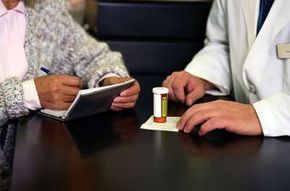As the population ages, spending on prescription drugs has been increasing faster than other aspects of our health care costs. From 1994 to 2003, prescription drug spending rose at double-digit rates each year. And it's still rising, although the increase can now be measured in single digits [source: Kaiser Family Foundation]. A few changes in the world of prescription medication have contributed to this slight slowdown in spending -- including the way health insurance companies offer prescription drugs. Many insurance plans have excluded high-cost drugs from coverage, cut down on refills and increased co-pays.
Prescription Drug Image Gallery
Advertisement
There has been much debate and research on how insurance companies can profitably meet our prescription drug needs. Let's find out what's going on.
Any insurance plan's prescription drug coverage includes a formulary, or a preferred drug list. It contains the medications your plan prefers and that can usually be prescribed without any prior authorization. This list is created to keep the drug costs down for the insurance company while still offering you a competitive choice of medications. One main purpose of the formulary is to encourage you to use the generic form of a given drug. If you don't choose the generic, some plans will charge more. Others may ask for the price difference plus the normal co-pay, some have a deductible for name-brand drugs and others will simply deny the coverage altogether.
A formulary can have several forms, depending on your exact insurance plan. Some plans will cover drugs that are on the formulary (preferred drugs, usually generic) and not on the formulary (nonpreferred drugs, usually brand-name), but you will generally have to pay more for nonpreferred drugs. Other insurance plans may be more cut-and-dried, covering only those drugs on the formulary and denying payment for all others without some sort of preapproval process. However, the majority of formularies are "tiered" -- somewhere in between. In a three-tier plan, generic drugs are usually at tier one, tier two includes brand-name drugs for which generics are not available, and tier three, the most expensive, contains nonpreferred drugs.
If your doctor prescribes a drug that isn't on your health insurance plan's formulary, most plans have an authorization process in which a drug may be approved on a case-by-case basis. Usually in these situations, you must have already failed with the approved treatments or experienced adverse effects from them. If your coverage is still denied, an appeal process is usually available.
So, how is a formulary created? Your insurance company has a committee that is normally composed of physicians, pharmacists and other health care providers. This committee selects drugs and other products on the formulary, keeping in mind factors like safety, efficacy and quality, along with the cost to the insurance company. Most formularies are reviewed and revised on a quarterly basis. New FDA-approved drugs may be added to the list, and noneffective or expensive older drugs may be removed.
So what happens if you can't afford the co-pays, or if you can't afford health insurance altogether? Salvation may come from the oddest places. Find out where in the next section.
Advertisement

